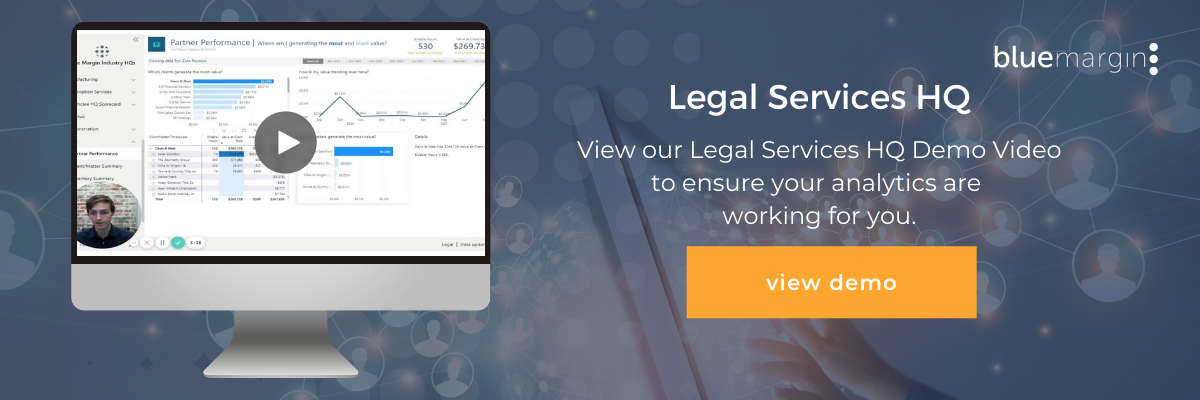Topic: Legal Data Intelligence
Assoc. Key phrase: Data Fails
What if 70 percent of your colleagues advocated for a new initiative, but only 29 percent were committed to supporting it once launched? The result could be a lot of wasted time and effort. You may be familiar with this dynamic, and its exactly what the Above the Law and Bloomberg Law survey discovered.
When asked about data analytics as strategic differentiator, 70 percent of lawyers agreed their firms would gain a competitive edge by using them (Green 2018).
So why is such a small percentage of firms willing to use data intelligence?
The answer may be in the high failure rate of data initiatives. In fact, the failure rates of data projects are estimated to be extremely high – between 60 and 85 percent (Henrion 2019). While this rate represents initiatives implemented across multiple industries, data analytics represents something new to many law firms. And something new means taking risks.
As Blane Prescott, a seasoned management consultant for the legal industry stated, “law firms, like most organizations, only change when they have to” (American Bar Association 2019).
But what if legal firms could identify and avoid the causes of failed data initiatives?
A Traditional Firm Model
Shawn Semmler and Zeeve Rose (2017) describe the traditional law firm model as hierarchical, with teams of associates conducting heavy research. That amount of research translates to more billable hours to the client. Those billable hours mean income, not just for the associates but for the partners at the top of the firms. When billable hours go down, so do the firm’s short-term profits.
Jon Thompson, Senior Partner at Blue Margin, describes how the traditional firm model can become an obstacle when evaluating data. The industry is “held back to some degree due to the operational norm…where action is often delayed to the end of the month or year, when the data is finally available.”
In a 2019 podcast interview with the Wharton University of Pennsylvania, Dave Walton shares that same sentiment. Walton, the chair of cyber solutions and data strategies at a Philadelphia law firm, stated, “Clients are ahead of us in using data, and now they’re looking at law firms to say, ‘How are you going to use your data to better provide services to me?’ But there’s an internal tension because a lot of law firms are still billing in the billable hour.”
If the traditional billable hour law firm is the problem, what’s the solution? Is there a way to adapt this model, or should it be transformed completely?
Semmler and Rose (2017) admit the traditional model could disappear entirely, but the more likely answer is adaptation. By bringing clarity both to billers and to clients, resistance to the traditional model can be greatly mitigated. Data analytics can rationalize costs, case timelines, and optimal use of billing resources.
Internally, firms can more proactively analyze and manage the levers that determine profitability: rates, hours, costs, how many produce fees vs. how many reap profits, and the net balance between write-downs and write-offs.
Meredith Slawe, one of the partners at Akin Gump law firm, was a panelist at the Ark Group Business Intelligence and Analytics in the Legal Profession Conference in 2018 (Mellor 2018). During the panel’s questioning, Slawe said, “It is when you combine rich data and thoughtful people that accurate and fully developed information emerges.” (Mellor 2018). Despite this underlying philosophy and intent of data analytics, lawyers can be resistant to their use due to fear.
One, they fear that data analytics and automation will replace them. This perception can come from a misconception about what data analytic tools are and how they work (Semmler and Rose 2017). While these tools are indeed powerful, knowing that it also takes human intelligence and insight to use and monitor them, and interpret data relevance eases fear (Semmler and Rose 2017).
Dave Walton (2019) frames the fear of becoming obsolete in terms of professional identity. He says lawyers tend to “have the idea that, ‘well, my brain was trained. My judgment is everything. My personal experience is everything. There is no way a computer could ever do my job.’” But, it’s actually not the tool’s job to replace the lawyers. Instead, it’s the tool’s job to provide supplemental data to help lawyers do their jobs and make better decisions.
A way to break through these misunderstandings is to start asking questions about how firms can adopt data analytics. Jon Thompson mentions several questions lawyers and consultants like Blue Margin can ask before implementing a data analytics strategy:
- What are the primary issues that hinder our growth, profitability, and service to clients?
- Who in the firm can most effect these issues given the right insights?
- What are the actions they need to take to improve outcomes?
- What insights drive those actions?
Another way to overcome lawyers’ fear of displacement is to encourage adaptation to changing roles. By becoming aware of what data-driven technologies can do, how they work, and implementing them, Thompson says “cashflow, operational performance, and client performance” will improve.
Inadequate Design and Insufficient Data
The foundation of any successful relationship is trust. And, when it comes to relationships between lawyers and their clients, that trust is built on client confidentiality. But the practice of collecting, storing, and using multiple forms of client data within data analytics tools can run counterintuitive to lawyers’ instincts. This can lead to resistance to identifying and using the right data to identify weaknesses and improve strategy.
How can firms ease the introduction of data analytics to their culture? Jon Thompson states that involving more than one person in the design of data initiatives is important. “Key stakeholders throughout the firm” should be involved and be “a voice of the customer” so it “fits the appropriate need.”
If recent surveys of law firms and the implementation of data initiatives are correct, over 60 percent of firms are gaining valuable insights about litigation strategy and advising clients from data analytics (Green 2018). However, only 36 percent of law firms are actually using data analytics (University of Cincinnati 2019), and those that do stand a higher chance of failing before succeeding.
Learn your law firm can use data more effectively
For Further Reading:
Lexis Legal Advantage/What is Legal Analytics?
Forbes/Why Is Law So Slow To Use Data?
Sources:
American Bar Association. “5 Top Trends Impacting the Legal Profession Now.” American Bar Association, 2019, https://www.americanbar.org/news/abanews/publications/youraba/2019/october-2019/a-management-consultant-on-how-to-navigate-5-trends-buffeting-la/
Author interview with Jon Thompson, September 14, 2021
Green, Darby. “Analytics Give Law Firms the Competitive Edge.” Bloomberg Law, 2018, https://news.bloomberglaw.com/business-and-practice/analytics-give-law-firms-the-competitive-edge
Henrion, Max. “Why Most Big Data Analytics Projects Fail.” ORMSI Today, 2019, https://pubsonline.informs.org/do/10.1287/orms.2019.06.08/full/
Mellor, Mike. “Law Firm Experts Reveal How They Use Data Analytics.” Legal Marketing Association, 2018, https://blog.legalmarketing.org/law-firm-experts-reveal-how-they-use-data-analytics
Semmler, Sean, and Zeeve Rose. "Artificial intelligence: Application today and implications tomorrow." Duke L. & Tech. Rev. 16 (2017): 85.
University of Cincinnati Libraries. “Legal Analytics.” University of Cincinnati, 2019, https://guides.libraries.uc.edu/legalanalytics
Wharton University of Pennsylvania. “The Next Legal Challenge: Getting Law Firms to Use Analytics.” Wharton University of Pennsylvania, 2019, https://knowledge.wharton.upenn.edu/article/getting-law-firms-to-use-analytics/
3 Trends in Legal Data Intelligence, 2021 - https://www.bluemargin.com/ttd/3-trends-in-legal-data-intelligence







